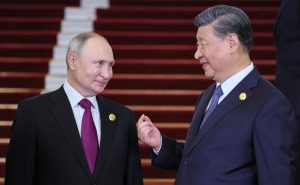The Trump administration’s apparent alignment with Moscow in the Russia-Ukraine conflict has fueled speculation that President Donald Trump may be pursuing a “reverse Kissinger” strategy. But the idea of a “reverse Kissinger” – aligning the United States with Russia to counterbalance China – is fundamentally flawed and lacks the geopolitical, economic, and strategic foundation necessary for success. While the Trump administration’s pivot toward Russia may appear to echo Nixon’s Cold War triangular diplomacy, the international context today is vastly different, rendering such a strategy impractical and counterproductive.
One of the most glaring obstacles to a “reverse Kissinger” approach is the robust partnership between China and Russia. Unlike the Sino-Soviet split of the 1970s that Nixon exploited, contemporary Sino-Russian relations are characterized by strategic alignment. The two nations have declared their friendship to be “without limits,” as evidenced by their joint statements and mutual support on key geopolitical issues. For instance, Russia has consistently backed China’s stance on Taiwan, while China has provided material and diplomatic support to Russia during its invasion of Ukraine. This level of cooperation demonstrates a shared vision for resisting Western dominance and undermines any possibility of driving a wedge between them.
Moreover, the trust deficit between Russia and the United States further complicates this strategy. Decades of sanctions, NATO expansion, and conflicting interests in Europe have left Moscow deeply skeptical of Washington’s intentions. Even if the U.S. were to extend an olive branch, it is unlikely that Russia would jeopardize its stable and mutually beneficial relationship with China for an uncertain alliance with a historically adversarial power.
Economically, China has become an indispensable partner for Russia, far outpacing Russia-U.S. trade relations. In 2023, China-Russia trade reached $240 billion, dwarfing Russia-U.S. trade at just $52 billion – a figure diminished by U.S. sanctions. Russia relies heavily on China as a buyer of its oil and gas exports, particularly after losing access to Western markets due to its actions in Ukraine. This economic interdependence provides China with significant leverage over Russia and makes any U.S. attempt to lure Moscow away from Beijing economically unviable.
Additionally, the United States itself lacks compelling economic incentives to offer Russia. As a net exporter of oil and gas under Trump-era policies, the U.S. has little need for Russian energy resources. Nor is Washington going to buy Russian arms, the other main pillar of Russia’s economy. Meanwhile, China’s Belt and Road Initiative has already established deep economic ties with Russia, offering infrastructure investment and technological collaboration that the United States is ill-equipped to match.
Even if the U.S. were able to improve relations with Russia, expecting Moscow to actively counterbalance Beijing is unrealistic. Russia’s long-term strategic goals align more closely with China’s than with the United States’. Both nations share an interest in challenging U.S.-led global institutions and reducing reliance on the dollar as a reserve currency. Furthermore, any hypothetical Russia-U.S. alignment would likely be temporary and fragile, as it would not address the fundamental ideological and geopolitical divides between Moscow and Washington.
Russia’s limited capacity to challenge China is another critical factor. After years of economic sanctions and military expenditures in Ukraine, Russia lacks the resources to compete with China’s growing influence in Asia or elsewhere. Even with U.S. support, Moscow would struggle to present a credible counterweight to Beijing’s economic might and technological advancements.
Nixon’s success in courting China during the Cold War was predicated on pre-existing hostilities between Beijing and Moscow – a dynamic that does not exist today. Attempting to replicate this strategy without similar conditions in place ignores the lessons of history and risks alienating allies while failing to achieve its objectives. Nixon’s triangular diplomacy was also part of a broader framework of détente that sought to stabilize global tensions; in contrast, Trump’s approach appears more transactional and less rooted in long-term strategic planning.
Pursuing a “reverse Kissinger” strategy could undermine U.S. credibility on multiple fronts. By aligning with an authoritarian regime like Russia while sidelining traditional allies in Europe and Asia, the United States risks eroding trust among its democratic partners. This could weaken NATO cohesion, embolden adversaries like China, and create openings for Beijing to expand its influence globally.
Moreover, such a policy shift could exacerbate domestic divisions within the United States. Critics would likely view it as abandoning core American values of democracy and human rights in favor of short-term geopolitical gains – a move that could face significant resistance both at home and abroad.
The notion of a “reverse Kissinger” is more fantasy than feasible policy. It underestimates the strength of Sino-Russian ties, overestimates Russia’s willingness and ability to align with the United States against China, and misjudges the complexities of today’s multipolar world order. Rather than attempting to revive outdated Cold War strategies, U.S. policymakers should focus on strengthening alliances with democratic nations, investing in economic competitiveness, and addressing global challenges through multilateral cooperation.
In an era defined by interconnectedness and shared challenges, simplistic power-balancing tactics are unlikely to succeed. Instead, a nuanced approach that recognizes the realities of modern geopolitics is essential for maintaining U.S. leadership on the global stage.

































